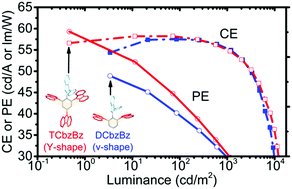Networking hole and electron hopping paths by Y-shaped host molecules: promoting blue phosphorescent organic light emitting diodes†
Abstract
1,3,5-(N,N′,N′′)-Tricarbazolyl-2-(benzimidazol-2-yl)benzene (TCbzBz) has been developed as a host for the FIrpic doped blue phosphorescent organic light emitting diodes. The Y-shaped 1,3,5-tricarbazole array networks the host molecules to form continuous hole and electron hopping paths that provide an improved hole mobility of 2.0 × 10−5 cm2 V−1 s−1. Significant breakthroughs on the efficiency of 58.2 cd A−1 and 59.4 lm W−1 with 28% of external quantum efficiency are therefore achieved. Usually aggregation of the emitter molecules will lead to triplet–triplet quenching and significantly hamper the performance of the PhOLEDs. However, the present networked matrix is so spacious that it can accommodate up to 12% of the FIrpic without hampering the device performance. Nano-aggregation in the sublimed film is clearly evidenced by atomic force microscopy, powder X-ray diffractometry, and UV-Vis spectrophotometry.



 Please wait while we load your content...
Please wait while we load your content...